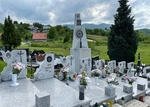Marking 31 years since the Visegrad atrocities: 3,000 roses for 3,000 victims

As a symbolic act to mark the 31st anniversary of the atrocities committed against Bosniak civilians in the eastern town of Visegrad, 3,000 roses were cast into the Drina River from the Mehmed-Pasa Sokolovic Bridge to pay tribute to the 3,000 victims on Saturday.
Activities to observe the anniversary will also include visits to Bikavac and the former Pionirska Street, which became sites of horrifying mass killings in 1992, and a collective funeral prayer will be held for eight more victims.
These victims, Bosniaks, were tragically slain in 1992, and their remains were unearthed in the regions of Visegrad, Srebrenica, and Zepa throughout the past few years.
Visegrad is known as the area where some of the most heinous crimes were committed during the conflicts in former Yugoslavia. The gruesome incidents at Bikavac and Pionirska Street were labelled as chilling examples of inhumanity throughout Milan Lukic's trial in The Hague, representing a dark chapter in humanity's history of atrocities.
On June 14, 1992, 140 women, children, and elderly individuals were burned alive in Adem Omeragic's house at Pionirska Street and Meho Aljic's house in Bikavac. The youngest victim, an unnamed baby in its mother's embrace, was merely two days old at the time.
The Head of the Association "Women-Victims of War” association, Bakira Hasecic, emphasized the significance of the commemoration and collective funeral prayer, stating:
"This serves as yet another testimony to the grievous war crimes committed in Visegrad. We are still searching for more than 600 missing persons who perished in the Visegrad municipality. It is crucial to note that approximately 500 women were killed here in Visegrad."
Hasecic hopes that "someone from the Serb community will come forward and disclose the location of the remains from the 'live pyres' in Visegrad, along with the remains of other slain civilians still missing."
Among those being laid to rest today in Visegrad, the youngest victim is Munevera Sabanija, born in Visegrad in 1970. She tragically lost her life in 1992, at the age of 22.
Her remains were discovered and exhumed in subsequent decades from two distinct locations: Straziste in 2005 and Djurevica Polje in 2010.
The Jasarevic brothers, Hajdar and Senad, will finally be laid to rest after three decades in Visegrad's Straziste cemetery as well. They disappeared in 1992, and their remains were unearthed at separate sites, eight and ten years following their deaths. Hajdar Jasarevic, only 28 years old, was tragically killed in the Rogatica municipality in 1992. His remains were exhumed from a mass grave discovered in Slap-Zepa in 2000.
His older brother Senad, at the age of 36, met his untimely demise in Visegrad. His remains were exhumed in 2002 from the Gornja Crnca in the area.
Two more women will be laid to rest. One of them is Asima Tvrtkovic, born in 1952, who went missing in this city in 1992. Her remains were discovered during the 2010 exhumation in Straziste. The other one is Hana Mujezinovic, born in 1941. She went missing in 1992 and her remains were exhumed 16 years later at Sjedace in Srebrenica.
The funeral will also be held for Hasib Nuhanovic, born in 1954. He also disappeared in 1992, and his remains were exhumed last July at the location of Gornja Crnca. Osman Ribac, born in 1932, will also be laid to rest on Saturday.
The oldest victim to be laid to rest is Amir Omerovic, who was 62 years old when he was executed in June 1992. His remains were exhumed 30 years later at Gornja Crnca.
Kakvo je tvoje mišljenje o ovome?
Učestvuj u diskusiji ili pročitaj komentare





 Srbija
Srbija
 Hrvatska
Hrvatska
 Slovenija
Slovenija



























































